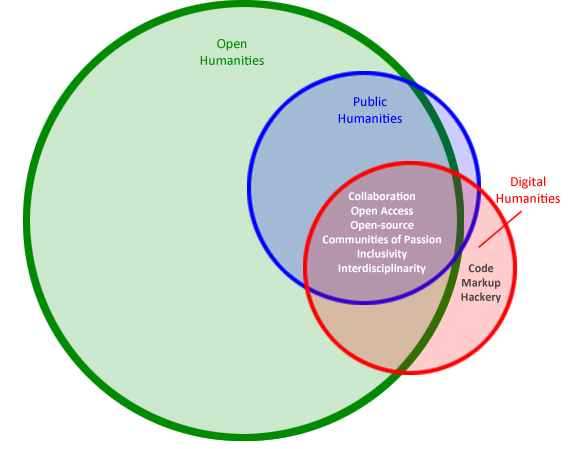In considering recent definitions of digital humanities, I’m often struck by some common aspects of many of them—the ones that have nothing to do with the digital:
“. . . essentially collaborative . . .”
“. . . a commitment to the openness of knowledge.”
” . . . interdisciplinary; by necessity it breaks down boundaries between disciplines . . .”
“Making stuff, and using it to collaborate and connect with the public . . .”
“. . . genuine interdisciplinarity . . . open communication.”
“. . . an inclusive, open community . . .”
“. . . using interdisciplinary approaches that may go beyond the comfort level of traditional scholars . . .”
They speak to me in large part because I really come from the museum (specifically public history) and library worlds, and many of those celebrated features of DH are fundamental aspects and approaches of those other fields as well—and have been for a long time. The practitioners in those fields? Well, they’re my people.
Libraries, museums, the digital humanities, and other public-facing humanities efforts share some or all of the following values:
- Collaboration
- Inclusivity
- Interdisciplinarity
- Open Access
- Open Process
- Open Source
- Involvement of the public and/or public “communities of passion”
I’ve started referring to this larger perspective as the open humanities. It’s a broad term that encompasses those values outlined above, values shared by many libraries, museums, public humanities projects and practitioners of all kinds and standing in opposition to much of the traditional approach of “solo scholar” research and closed publication.
If I were to offer a first-pass attempt at capturing these elements in a definition, I might say something like: the open humanities are those aspects of the humanities aimed at democratizing production and consumption of humanities research. It makes no judgment on the precise manner or praxis in which this work is done or delivered.
And because I work in a digital humanities shop, I wanted to show my take on the relationship between digital humanities and the wider open humanities:
The digital humanities are a part of the open humanities to the extent that those same values are held, though of course the purely digital elements (the code, the markup, the hardware) are unique to the digital humanities and live largely outside of OH. That being said, much of DH—the commitment to open source, the collaborative nature of the field, the interdisciplinarity—is open.
As a comparison, the public humanities are virtually entirely open by my definition, so they are included entirely within the circle of OH almost entirely open by my definition, but as Sheila Brennan points out there are still elements even within those institutions that don’t support openness at every turn. (See my original diagram here.) There is also some overlap between public humanities and the digital humanities, as some—but not all—public humanities projects are also digital. You see how this starts getting a little overly-Venn-diagrammatical, but you can probably see where I’m going.
Those who know me know that I’m no coder—some might say that means I’m not much of a digital humanist. I’d say I’m a proud open humanist with one foot solidly in the digital. That counts as DH for me.

[…] the aspects of the field that might particularly be considered “public” or “open.” I’d love to get into a conversation about this stuff. Maybe we can take a look at […]
[…] on cybernetickinkwell.com Posted by George Misc Subscribe to RSS […]
[…] terms like “open” and “collaboration” are used in definitions of digital humanities, Eric Johnson suggests that the digital humanities have much in common with the public humanities. Like museum […]